
Isuzu Motors Limited, Headquartered in Yokohama, Kanagawa, Japan is a Japanese multinational automobile manufacturer. Its principal activity is the production, marketing and sale of Isuzu pickup trucks and SUVs, commercial vehicles and diesel engines. Isuzu products working hard in Japan and abroad.
| Categories |
| Isuzu vehicles (Latest-2024) Isuzu Archive 3 (2023-2015) Isuzu Archive 2 (2014-2000) Isuzu Archive 1 (1999-1922) |
| Websites |
| see below |
| Isuzu Motors Limited Brand and Models |
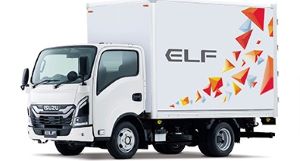 ELF ELF
Launched in 1959, the N-Series (ELF in Japan) is Japan’s representative light-duty truck. Recognized for its outstanding combination of economy, safety, reliability and durability, it is the best-selling light-duty truck in numerous countries around the world. |
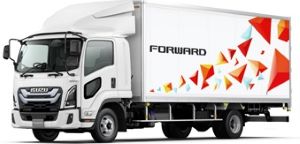 FORWARD FORWARD
F-Series (FORWARD in Japan) medium-duty trucks support a wide range of applications including arterial transportation and inner-city delivery, as well as various construction tasks and operations. A variety of models are available, including a 4-bag air suspension model offering high-quality transportation and a short-cab model with increased load efficiency. The F-Series is especially well received in Asia and Australia. A full model change in 2023 significantly enhanced environmental performance, safety and economy. |
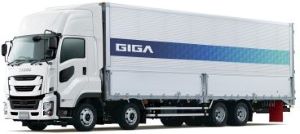 GIGA GIGA
The C&E Series (GIGA in Japan) heavy-duty truck and tractor series is designed to proactively reduces costs and enhance safety. It is equipped with 4-bag air suspension, the Smoother-Gx mechanical automatic transmission and VAT advanced visual support technology. The C-Series truck and E-Series tractor models have No.1 share in Australia and New Zealand markets, and are growing in popularity in China and Hong Kong. |
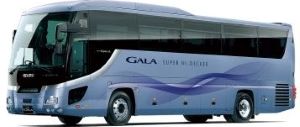 GALA Sightseeing Bus GALA Sightseeing Bus
The GALA sightseeing bus is made in both large GALA tour bus and GALA Mio mid-size bus configurations for sightseeing and private use. The GALA series features high levels of environmental performance, safety and comfort, providing a smooth and comfortable ride. |
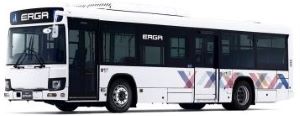 ERGA Route Bus ERGA Route Bus
The large ERGA for route/private-use and the mid-size ERGA Mio route buses comply with barrier-free transportation regulations and feature universal design, utilizing standardized specifications to help achieve non-step bus certification. |
 ERGA DUO ERGA DUO
The first hybrid articulated bus produced in Japan, this large capacity bus secures mass transit and features advanced safety functions. |
 ISUZU D-MAX ISUZU D-MAX
The D-MAX 1-ton pickup truck’s proven performance has made it popular around the world. Notably in Thailand, Isuzu’s pickup manufacturing and export base, the D-MAX enjoys overwhelming popularity for its beautiful styling and power. |
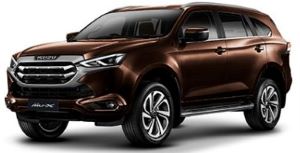 ISUZU MU-X ISUZU MU-X
The development of the MU-X PPV (Pick-up Passenger Vehicle) was derived from the D-MAX, further refining stability, comfort, safety and control, to meet the expectations and needs of customers around the world. |
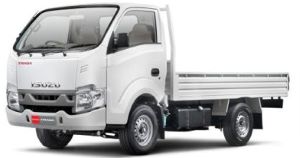 TRAGA (Indonesia) TRAGA (Indonesia)
TRAGA is a cab-over lightweight truck for emerging markets. It was engineered based on the D-MAX pickup truck, adopting the company’s extensive commercial vehicle technologies with the aim of optimizing load efficiency, turning, and fuel efficiency to provide exceptional customer benefits. |
Isuzu Motors Engine Sales Co., Ltd | ies-isuzu.co.jp
Isuzu Motors Engine Sales Co., Ltd. is a strategic engine specialist for the Isuzu Group that manufactures and sells marine engines, industrial engines, and various generators based on Isuzu truck-mounted engines that are lightweight, fuel efficient, and environmentally friendly. It’s a company.
Industrial Diesel Engines: In addition to developing industrial diesel engines that include Isuzu’s own state-of-the-art technology and have powerful moving capabilities, Isuzu is continuously charging ahead in pursuit of reliability, durability, and eco-friendliness. Isuzu offers a wide-ranging line-up of low- and high-displacement engines. Isuzu will bring reliability to the world as the global standard for future generations.
Marine Diesel Engines: Wide range of line-ups, World-widely distributed. Isuzu produces a wide range of high-performance marine engines that leverage the cost efficiencies and clean emissions of Isuzu Diesel technologies used in our automotive engines.
Isuzu Commercial Truck of America, Inc.
Headquartered in Anaheim, California, Isuzu Commercial Truck of America, Inc. is the distributor of Isuzu commercial vehicles in the United States. Isuzu commercial trucks have been the bestselling low-cab-forward trucks in America every year since 1986. Isuzu has nearly 300 Isuzu dealerships nationwide and each of them offers a multitude of services .
Isuzu Commercial Truck of America, Inc.
1400 S. Douglass Rd., Suite 100,
Anaheim, CA, United States, 92806
(866) 441-9638
isuzucv.com | (Isuzu Commercial USA)
isuzu.com | (Product Portal website for Isuzu Motors America)
isuzuengines.com | (PowerTrain Division for Isuzu Motors America)
isuzutruckservice.com | (website provides information for Isuzu’s line of 1996-to-current commercial vehicles.)
Isuzu Motors UK
Isuzu Motors UK began in 1987 to import and distribute the Isuzu Motors Trooper model, today equipped with a punchy turbo diesel engine, the D-Max pick-up delivering 164PS and 360Nm of torque. Each new model comes with a 125,000 mile/5-year warranty and 5 years UK and European roadside assistance. With towing capabilities of 3.5 tonnes, a maximum payload of 1,205kg and a 4×4 drive, the Isuzu D-Max works for customers day and night achieving up to 39.4mpg, meeting Euro 6D emissions standards.
Customer Support Team, Monday – Friday 9am until 5.30pm, Call us on 01285 647670
isuzu.co.uk
Isuzu Truck UK Ltd
Formed in 1996, the company has grown considerably and developed a comprehensive dealer network that now spreads extensively throughout England, Scotland and Wales. In 2013 the company became a wholly-owned subsidiary of Isuzu Motors Ltd Japan. Isuzu Truck UK purpose-built headquarters based in Hatfield, Hertfordshire is the home of Isuzu Truck UK finance & administration, customer CARE, technical service and marketing & sales operations. It was also designed with a state-of-the-art technical centre which carrys out all of the technical training for Isuzu Truck UK dealer service personnel – in particular the all-important technicians. All Isuzu trucks built for the UK market are manufactured in Japan.
Isuzu Truck UK Ltd
Isuzu House
164 Great North Road
Hatfield
Hertfordshire
AL9 5JN
UK
Tel: 01707 28 29 30
isuzutruck.co.uk

Company

Isuzu Motors Limited is a publicly listed company traded on the Tokyo Stock Exchange ( Code: 72020 )
Founded on 30 March 1934 (as Isuzu)
Headquarters in Yokohama Gate Tower, Nishi-ku, Yokohama, Kanagawa Prefecture, Japan
Isuzu Motors Limited
1-2-5, Takashima, Nishi-ku, Yokohama-shi, Kanagawa, 220-8720, JAPAN
Tel. +81-45-299-9111
isuzu.co.jp
| Name | Isuzu Motors Limited |
|---|---|
| Foundation/Establishment | 1916 / April 1937 |
| Capital | 40.6 billion yen (March 2023) |
| Representative | Masanori Katayama, Chairman and Representative Director, CEO Shinsuke Minami, President and Representative Director, COO |
| Sales | Consolidated 3,195.5 billion yen Non-Consolidated 1,306.8billion yen (FY2022) |
| Employees | Consolidated 44,495 Non-Consolidated 8,056 (March 2023) |
| Major Products | Light-, medium- and heavy-duty trucks, buses, passenger vehicle engines, industrial-use diesel engines. |
| Subsidiaries | Anadolu Isuzu, Sollers-Isuzu, SML Isuzu, IAMI, Isuzu Commercial Truck of America, Inc., Isuzu HICOM Malaysia, Isuzu Malaysia, Isuzu Philippines, Isuzu UK, Isuzu South Africa, Taiwan Isuzu Motors, Isuzu Vietnam, Isuzu Motors India, UD Trucks, Industries Mécaniques Maghrébines |

